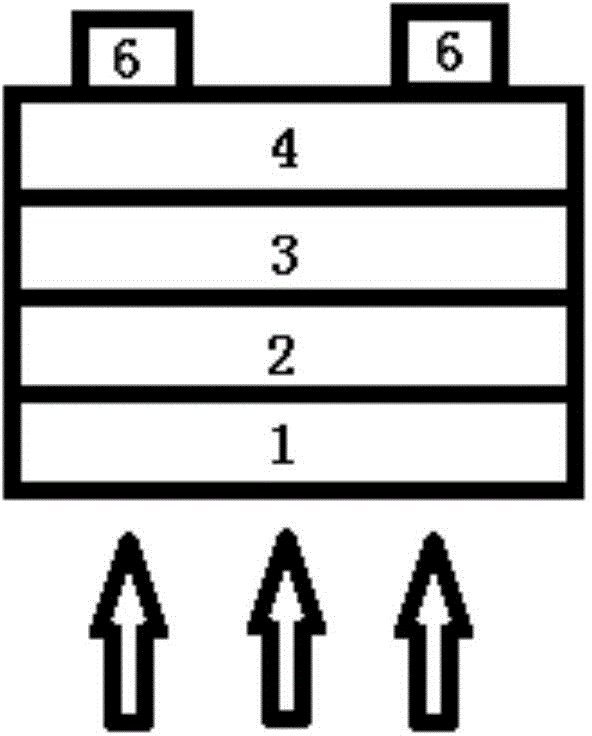Compound film solar battery and manufacturing method thereof
A technology of solar cells and compounds, applied in circuits, electrical components, photovoltaic power generation, etc., can solve the problems of low element content, toxic production process for human body, complexity, etc., and achieve the effect of low-cost production and excellent photovoltaic performance
- Summary
- Abstract
- Description
- Claims
- Application Information
AI Technical Summary
Problems solved by technology
Method used
Image
Examples
Embodiment 1
[0054] Embodiment 1, including the step of depositing a transparent electrode layer, the step of depositing an N-type buffer layer, the step of depositing a P-type absorber layer, and the step of depositing a back electrode layer:
[0055] 1. The step of depositing a transparent electrode layer: depositing a transparent electrode layer 2 on the surface of the substrate 1 by magnetron sputtering;
[0056] The substrate is glass with a thickness of 3.2cm;
[0057] The transparent electrode layer is SnO 2 : F, the thickness is 800nm;
[0058] 2. The step of depositing an N-type buffer layer: depositing an N-type buffer layer 3 on the transparent electrode layer 2 by a solution coating method;
[0059] The N-type buffer layer is TiO 2 Material, with a thickness of 500nm;
[0060] Add 50ml of absolute ethanol, 7.5ml of triethanolamine, and 8.5ml of tetra-n-butyl titanate to the flask in turn, seal the flask and stir for 2 hours, then add 10ml of glacial acetic acid and 10ml of ...
Embodiment 2
[0067] Embodiment 2, including the step of depositing a transparent electrode layer, the step of depositing an N-type buffer layer, the step of depositing a P-type absorber layer, and the step of depositing a back electrode layer:
[0068] 1. The step of depositing a transparent electrode layer: depositing a transparent electrode layer 2 on the surface of the substrate 1 by electron beam evaporation;
[0069] The substrate is glass with a thickness of 3.2cm;
[0070] The transparent electrode layer is SnO 2 : F, the thickness is 1000nm;
[0071] 2. The step of depositing an N-type buffer layer: depositing an N-type buffer layer 3 on the transparent electrode layer 2 by a solution coating method;
[0072] The N-type buffer layer is a ZnO material with a thickness of 500nm;
[0073] 1.1g of Zn(Ac)2·2H2O and 0.29g of LiOH·H2O were respectively dissolved in 50mL of absolute ethanol, cooled to 0°C, titrated the LiOH solution into Zn(Ac)2 in 10 minutes, and stirred for 1 hour Ta...
Embodiment 3
[0079] Embodiment 3, including the step of depositing a transparent electrode layer, the step of depositing an N-type buffer layer, the step of depositing a P-type absorber layer, and the step of depositing a back electrode layer:
[0080] 1. The step of depositing a transparent electrode layer: depositing a transparent electrode layer 2 on the surface of the substrate 1 by magnetron sputtering;
[0081] The substrate is glass with a thickness of 3.2cm;
[0082] The transparent electrode layer is SnO 2 : F, the thickness is 800nm;
[0083] 2. The step of depositing an N-type buffer layer: depositing an N-type buffer layer 3 on the transparent electrode layer 2 by electron beam evaporation;
[0084] The N-type buffer layer is TiO 2 material, the thickness is 120nm;
[0085] Using TiO 2 target, pump the chamber to a vacuum of 5×10 -4 Pa, rotate the substrate table at a speed of 3rpm, wait until the substrate temperature is heated to 350°C, and pre-melt the TiO with the ele...
PUM
| Property | Measurement | Unit |
|---|---|---|
| Thickness | aaaaa | aaaaa |
| Thickness | aaaaa | aaaaa |
| Thickness | aaaaa | aaaaa |
Abstract
Description
Claims
Application Information
 Login to View More
Login to View More - R&D
- Intellectual Property
- Life Sciences
- Materials
- Tech Scout
- Unparalleled Data Quality
- Higher Quality Content
- 60% Fewer Hallucinations
Browse by: Latest US Patents, China's latest patents, Technical Efficacy Thesaurus, Application Domain, Technology Topic, Popular Technical Reports.
© 2025 PatSnap. All rights reserved.Legal|Privacy policy|Modern Slavery Act Transparency Statement|Sitemap|About US| Contact US: help@patsnap.com



